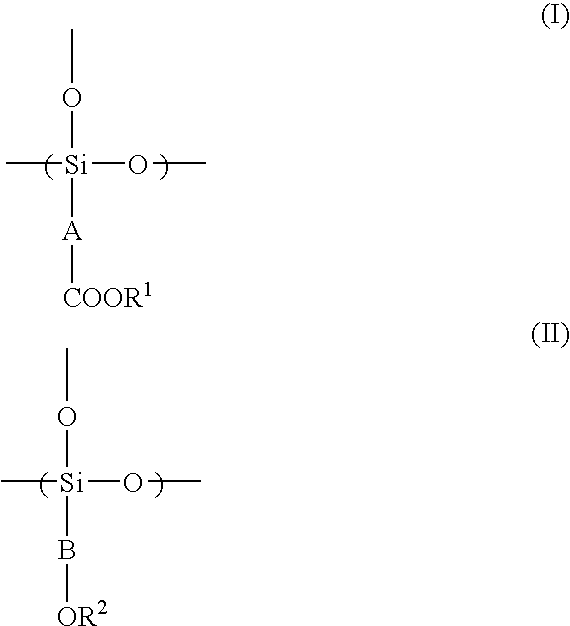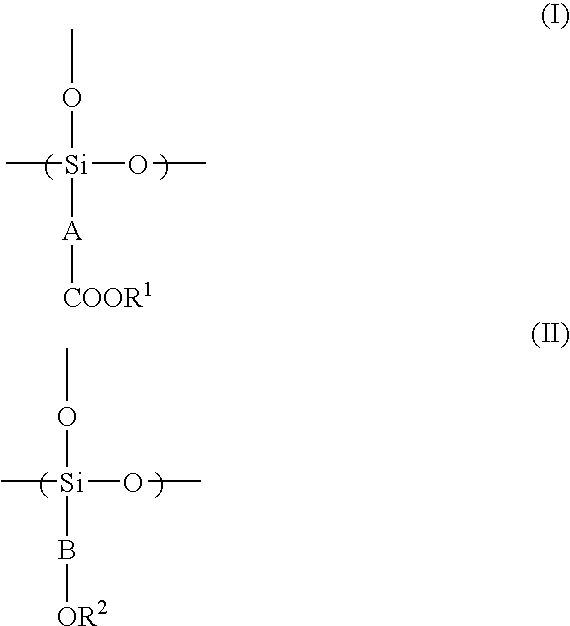Radiation-Sensitive Resin Composition
a technology of radiosensitivity and resin, applied in the direction of photosensitive materials, instruments, photomechanical equipment, etc., can solve the problems of high resolution, cracks and peeling of resist films, and high resolution of polysiloxane, so as to achieve excellent depth of focus, reduce development defects, and high transparency
- Summary
- Abstract
- Description
- Claims
- Application Information
AI Technical Summary
Benefits of technology
Problems solved by technology
Method used
Image
Examples
synthesis example 1
Preparation of Siloxane Resin (α-1)
[0230] A three-necked flask equipped with a stirrer, a reflux condenser, and a thermometer was charged with 42.8 g of a silane compound shown by the following formula (i-1), 16.3 g of a silane compound shown by the following formula (iii-1) (hereinafter referred to as “silane compound (iii-1)”), 14.4 g of a silane compound shown by the following formula (ii-1) (hereinafter referred to as “silane compound (ii-1)”), 26.5 g of a silane compound shown by the following formula (v-1) (hereinafter referred to as “silane compound (v-1)”), 100 g of 4-methyl-2-pentanone, and 27.2 g of a 1.75 wt % aqueous solution of oxalic acid. The mixture was reacted at 60° C. for six hours while stirring. The flask was cooled with ice to terminate the reaction.
[0231] 40.1 g of distilled water and 56.3 g of triethylamine were added to the reaction solution and stirred at 80° C. in a nitrogen stream for six hours, followed by cooling with ice. An aqueous solution of 42.3 ...
synthesis example 2
Preparation of Siloxane Resin (α-2)
[0233] A three-necked flask equipped with a stirrer, a reflux condenser, and a thermometer was charged with 45.3 g of a silane compound shown by the following formula (i-2) (hereinafter referred to as “silane compound (i-2)”), 15.6 g of the silane compound (iii-1), 13.8 g of the silane compound (ii-1), 23.5 g of the silane compound (v-1), 100 g of 4-methyl-2-pentanone, and 26.0 g of a 1.75 wt % aqueous solution of oxalic acid. The mixture was reacted at 60° C. for six hours while stirring. The flask was cooled with ice to terminate the reaction.
[0234] 38.4 g of distilled water and 53.9 g of triethylamine were added to the reaction solution and stirred at 80° C. in a nitrogen stream for six hours, followed by cooling with ice. An aqueous solution of 40.5 g of oxalic acid dissolved in 538.3 g of distilled water was added to the mixture, followed by further stirring. The reaction solution was poured into a separating funnel to remove the water layer...
synthesis example 3
Preparation of Siloxane Resin (α-3)
[0236] A three-necked flask equipped with a stirrer, a reflux condenser, and a thermometer was charged with 46.52 g of a silane compound (i-1), 27.43 g of a silane compound shown by the following formula (ii-2) (hereinafter referred to as “silane compound (ii-2)”), 26.04 g of the silane compound (v-1), 100 g of 4-methyl-2-pentanone, and 26.8 g of a 1.75 wt % aqueous solution of oxalic acid. The mixture was reacted at 60° C. for six hours while stirring. The flask was cooled with ice to terminate the reaction.
[0237] 39.5 g of distilled water and 56.2 g of triethylamine were added to the reaction solution and stirred at 80° C. in a nitrogen stream for six hours, followed by cooling with ice. An aqueous solution of 41.6 g of oxalic acid dissolved in 595.0 g of distilled water was added to the mixture, followed by further stirring. The reaction solution was poured into a separating funnel to remove the water layer. The organic layer was repeatedly wa...
PUM
| Property | Measurement | Unit |
|---|---|---|
| wavelength | aaaaa | aaaaa |
| wavelength | aaaaa | aaaaa |
| wavelength | aaaaa | aaaaa |
Abstract
Description
Claims
Application Information
 Login to View More
Login to View More - R&D
- Intellectual Property
- Life Sciences
- Materials
- Tech Scout
- Unparalleled Data Quality
- Higher Quality Content
- 60% Fewer Hallucinations
Browse by: Latest US Patents, China's latest patents, Technical Efficacy Thesaurus, Application Domain, Technology Topic, Popular Technical Reports.
© 2025 PatSnap. All rights reserved.Legal|Privacy policy|Modern Slavery Act Transparency Statement|Sitemap|About US| Contact US: help@patsnap.com



